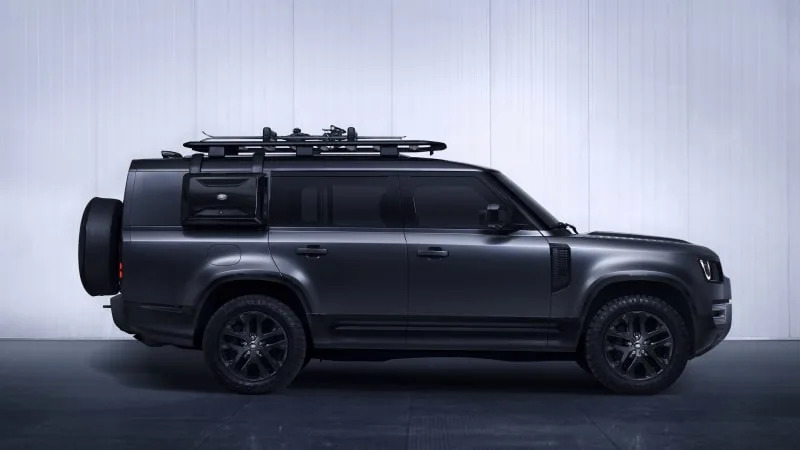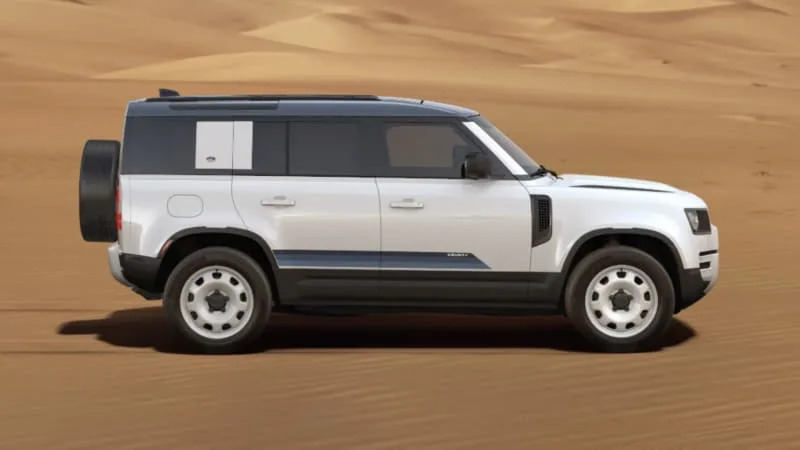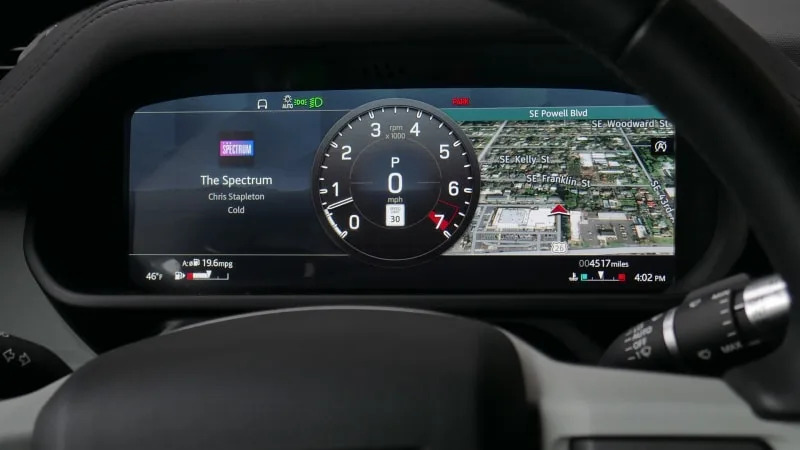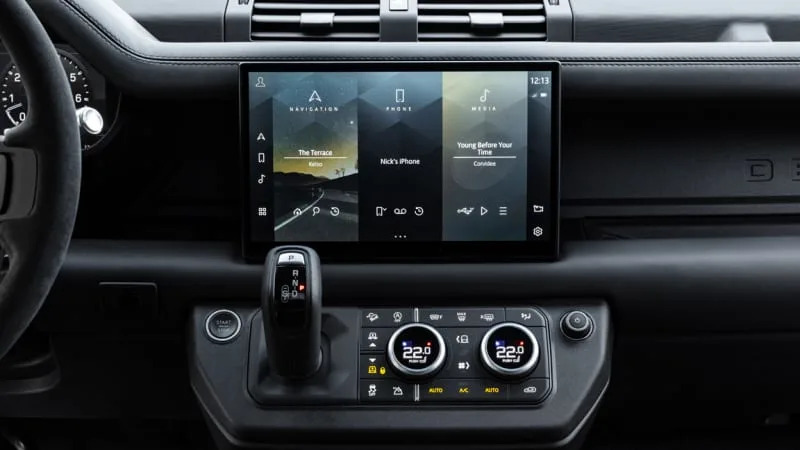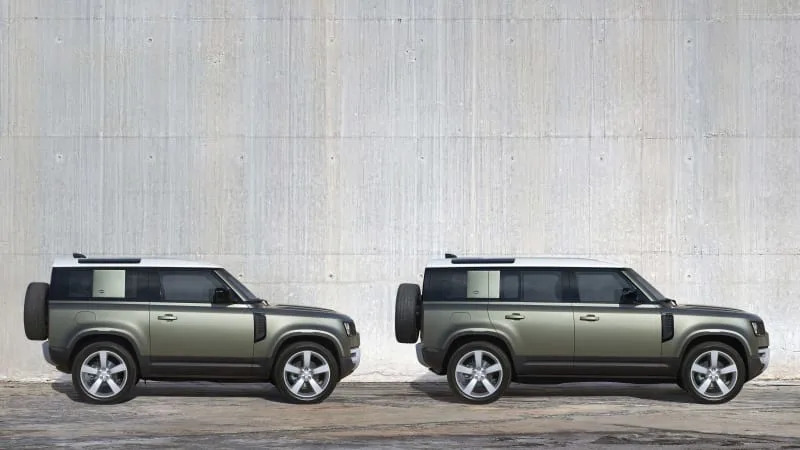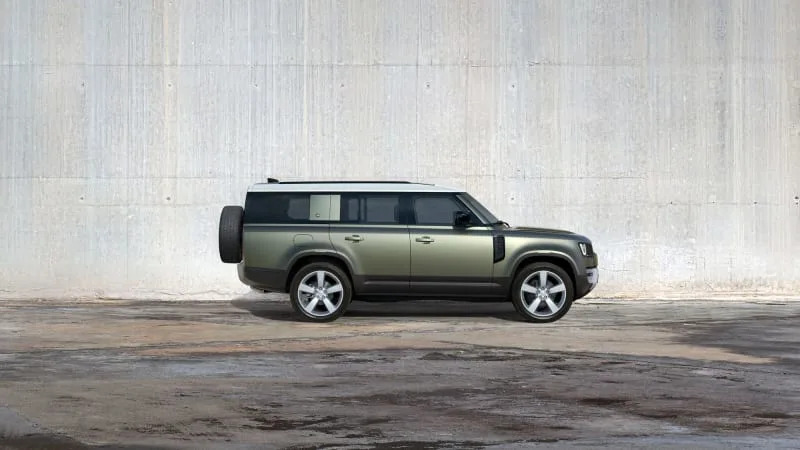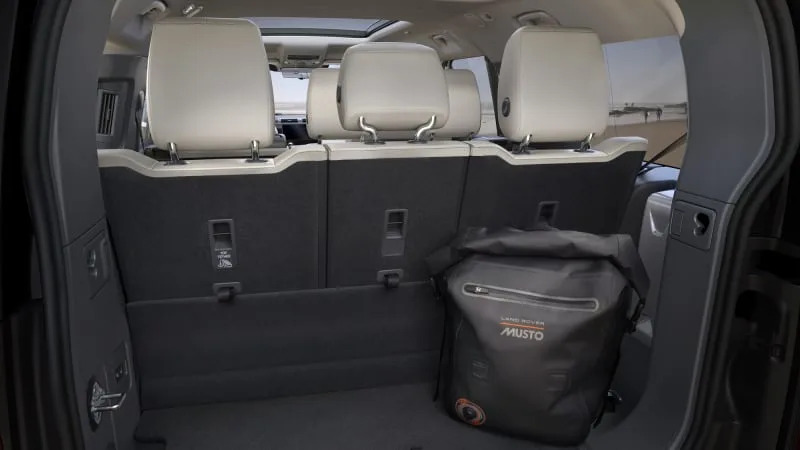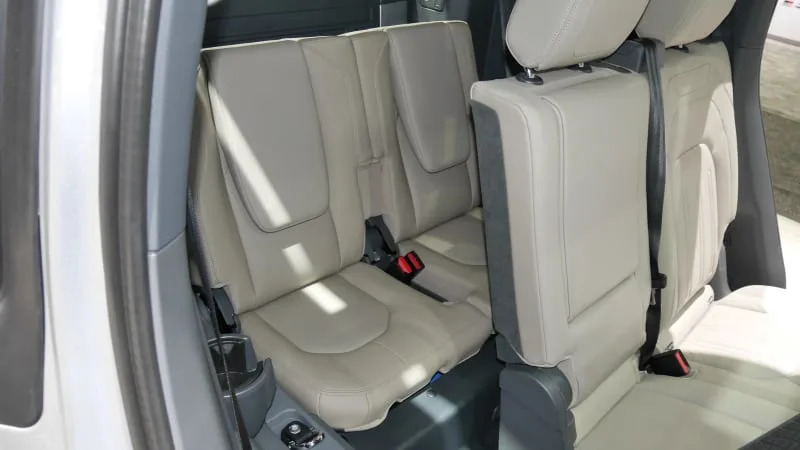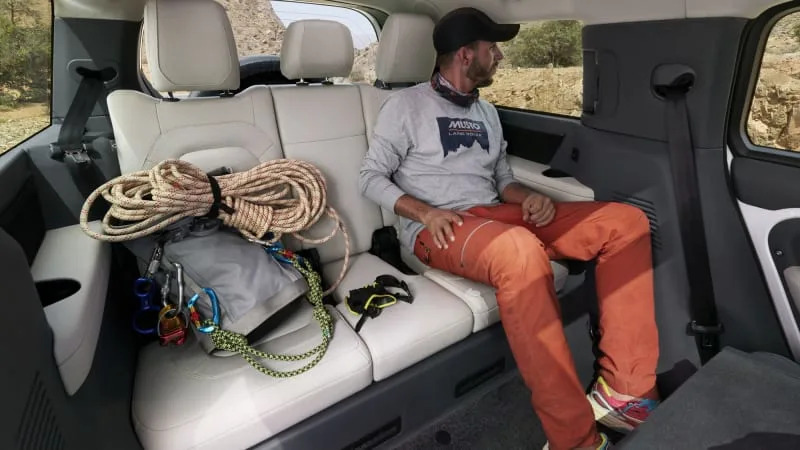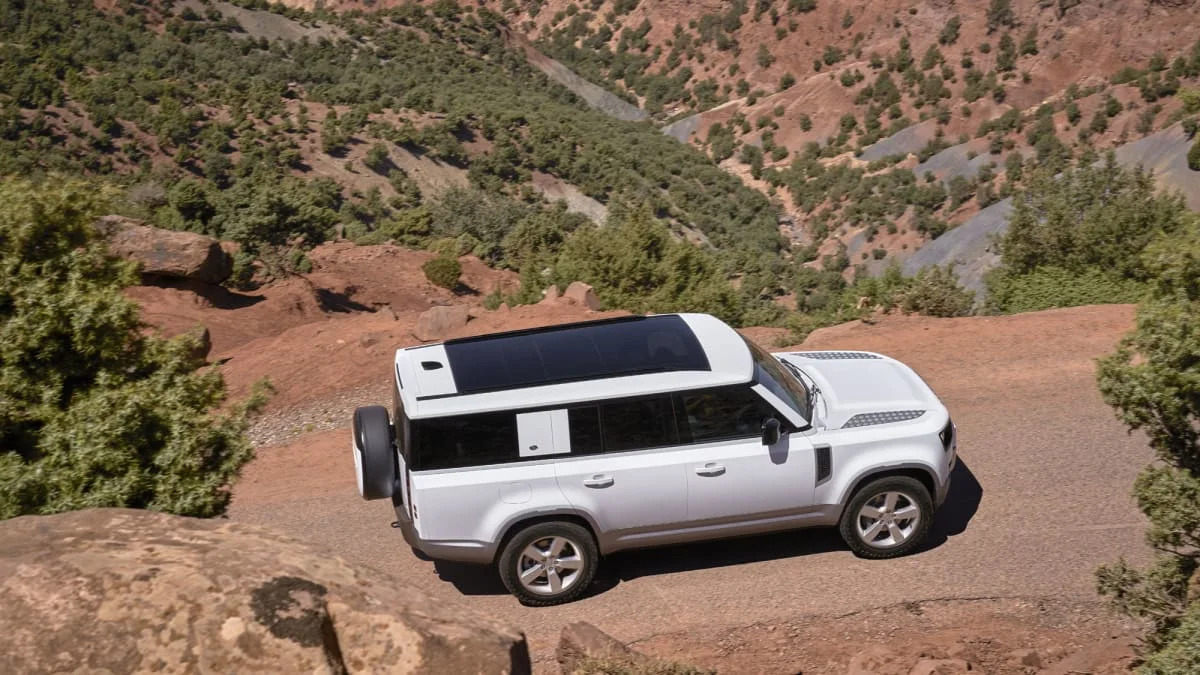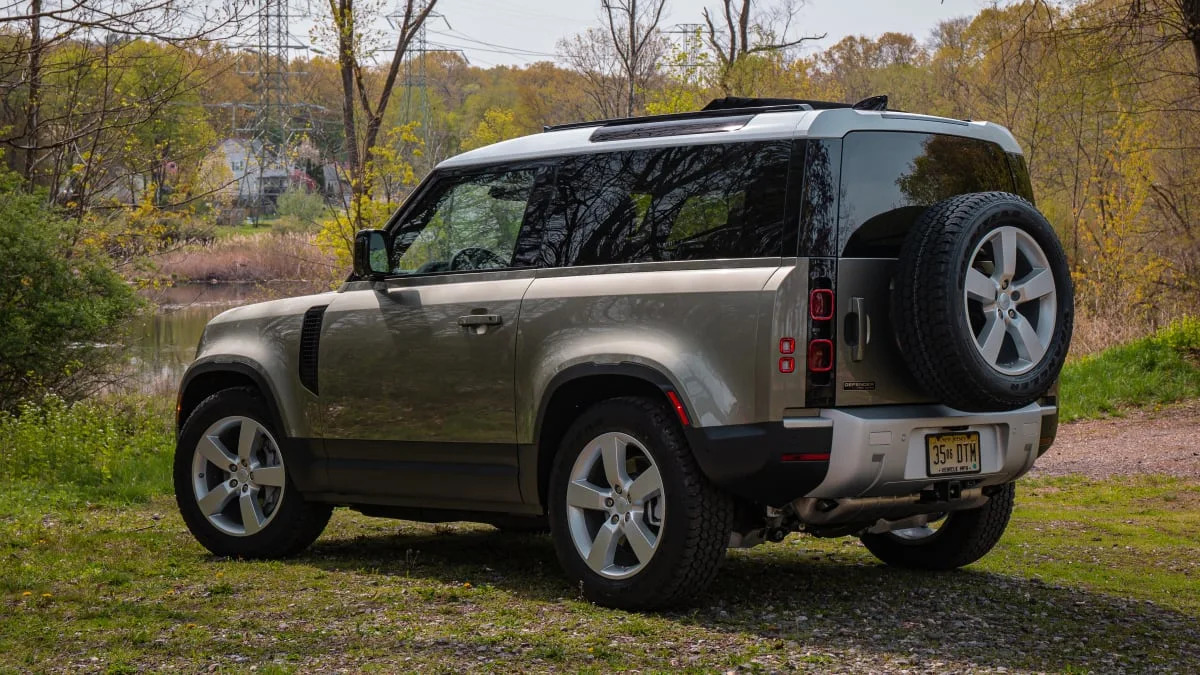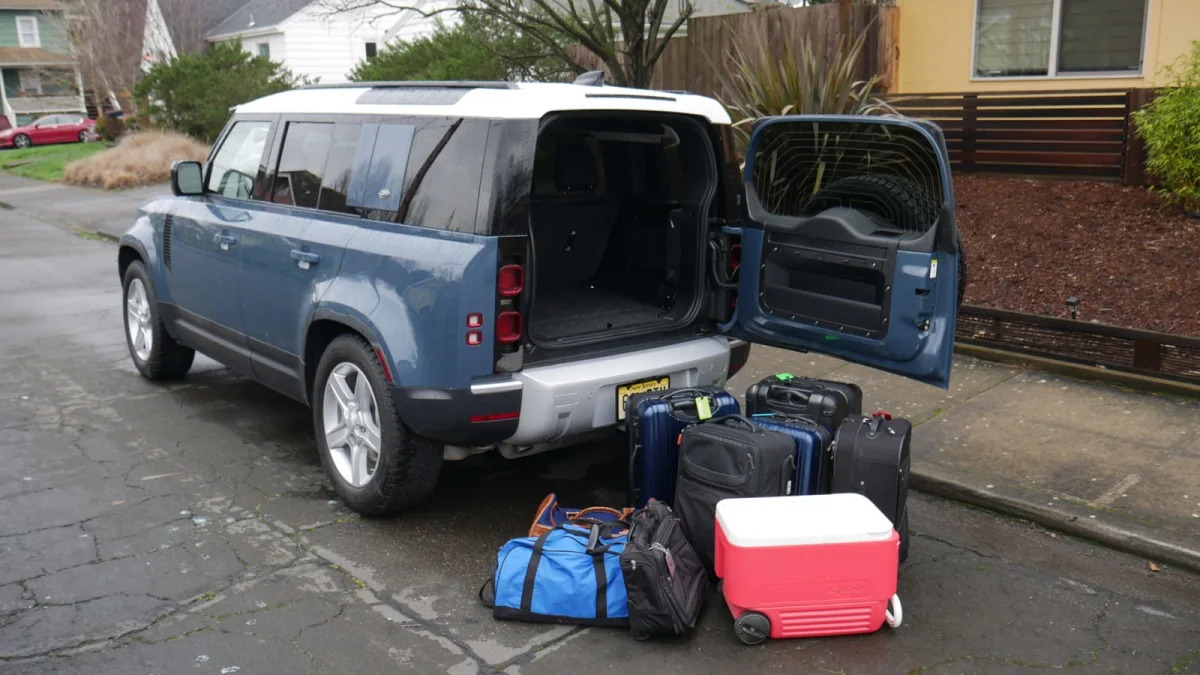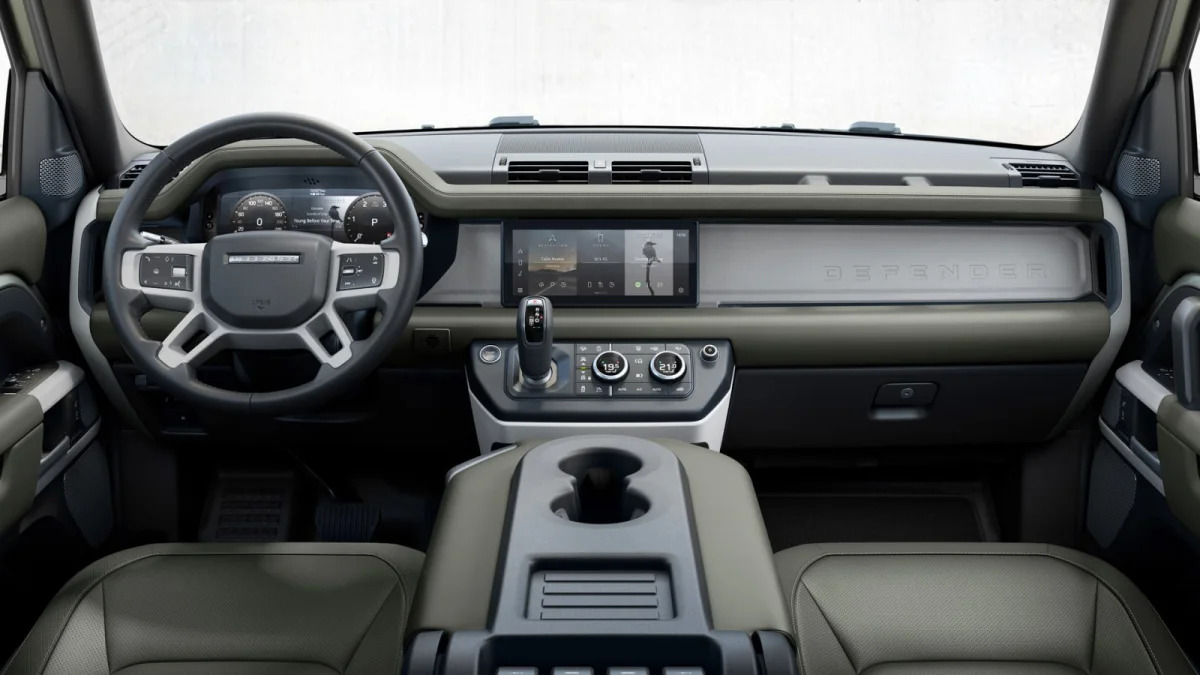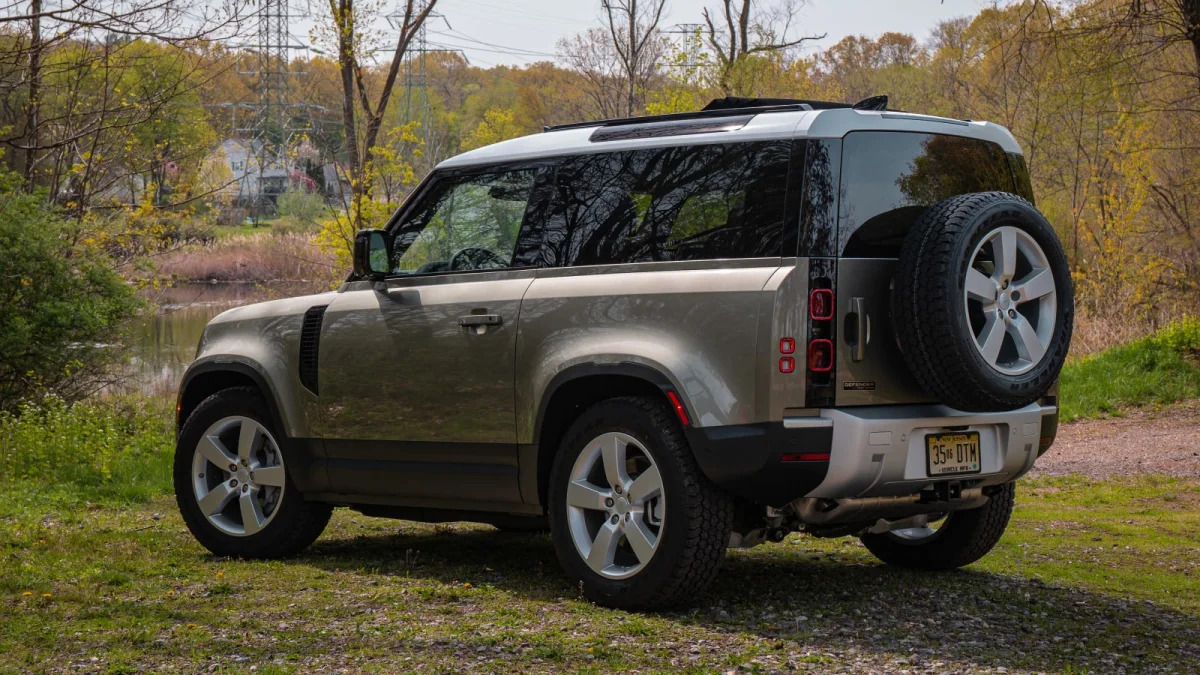Pros: Variety of engine and body styles; excellent ride, handling and interior noise for an off-roader; go-anywhere capability
Cons: Sub-par fuel economy for a luxury SUV; poor cargo space behind third rows; pricey trims not overtly luxurious
The 2024 Land Rover Defender is a big, boxy, off-road-ready SUV, which means it’s a very sought-after commodity at the moment – even if many owners have no intention of getting it muddier than what a Target parking lot on a rainy day can throw at it. If you do, however, that’s great! It can definitely take you far off the beaten path. Of course, so can other big, boxy off-roaders. How the Defender stands out is that it doesn’t make you suffer through rough rides, sloppy handling, booming interior noise, compromised interior space or course power plants. It’s practical, refined, comfortable and spacious, too. OK, so the two-door Defender 90 isn’t so spacious, but the three-row, eight-passenger Defender 130 certainly is.
Basically, we love the Defenders, and if money is no object, it’s one of the best SUVs you can buy, period. Trouble is, money typically is an object and there’s no getting around the fact that the Defender is very expensive. The cheapest, four-cylinder-powered 90 and 110 are just on either side of $60,000; while range-topping, V8-powered ones are well into six-figure territory. While you certainly get more than the Jeep Wranglers and Ford Broncos of the world, you’re also paying luxury prices for something that definitely doesn’t have the luxury vibes of a comparably priced BMW, Mercedes or even Range Rover. As such, we think the cheaper Defenders are the better buys as you’re not really missing out on much. But hey, if you’ve got the cash, you probably won’t regret enjoying the decadent, rich rumble of a V8 and the silky, effortless power it provides. It’s hard not to be smitten.
Interior & Technology | Passenger & Cargo Space | Performance & Fuel Economy
What it’s like to drive | Pricing & Trim Levels | Crash Ratings & Safety Features
What’s new for 2024?
A second, slightly less powerful V8 engine option is added to the Defender lineup, but its availability depends on the model. Good for 493 horsepower and dubbed P500, it is the only V8 option for the 130, which wasn’t available with a V8 at all last year. It is also the new engine for the Defender 110 SE trim level, but the V8 engine in the Defender 110 “V8” trim level (as well as the Carpathian Edition) remains the 518-hp P525 engine. That continues to be the only V8 engine option for the Defender 90. Confusing? Sure is! How this at all makes sense when we’re only talking 25 extra horsepower is beyond us.
Less confusing are two new Defender flavors. The Defender 130 Outbound (above in dark grey) is effectively a two-row, five-passenger 130 for those who need max cargo capacity. It also gets unique matte finish bumpers and grille insert, plus 20-inch wheels wrapped in all-terrain rubber. It’s more of an adventure rig than a family hauler. A new Defender 110 County exterior pack (above in white) also debuts for the S and SE trim levels. It features special graphics and unique wheels, including an option to have them painted to Gloss White. Finally, a new Loadspace Floor Tray is now standard on the 90 and eight-passenger 130. Access to the 90’s back seat has also been improved with a redesigned front passenger seat.
What are the Defender interior and in-car technology like?
With its bold horizontal lines, metal trim, rubber flooring, numerous grab handles and bins galore, the Defender’s cabin has an undeniably rugged and functional vibe. Certainly more so than any other Land Rover today. However, it may be rugged in appearance, but the materials used are generally top-notch stuff worthy of commanding its top-notch price tag. Top trim levels can also be spiffed up with open-pore wood trim and fancy two-tone leather choices, but it’s also not enough to create the sort of luxurious look and feel you’d find in other SUVs pushing and passing $100,000.
Standard on every Defender is Land Rover’s Pivi Pro 10-inch-wide touchscreen (above middle) interface, but an optional, taller 11.4-inch touchscreen is available. The 10-inch standard screen is handsomely sandwiched in between the dash’s prominent horizontal cross-members, making it almost appear to be a cool retroactive modification. The larger screen juts out beyond those cross-members for a less elegant, integrated appearance. The user interface provided by those screens isn’t as well sorted as those of rival systems (we’ve found it to be buggy at times and the radio controls can frustrate), but the graphics and overall aesthetic are pleasingly modern. The widescreen also doesn’t take advantage of its super-wide layout with a split screen option. The optional all-digital instruments make a stronger impression, as they offer different design choices that’ll provide as much or as little info as you’d like. That said, we’d also be just fine with the standard analog gauge cluster.
How big is the Defender?
No other SUV offers a comparable variety of body sizes. The most popular body style is the four-door Defender 110, which is sized comparable to a midsize luxury SUV like a BMW X5. The two-door Defender 90 is then a whopping 17 inches shorter in overall length than the 110 with a 10-inch shorter wheelbase; while the eight-passenger Defender 130 has the same wheelbase as the 110 but is 13.6 inches longer (or about the same as a Lincoln Navigator).
The 90’s small size makes it considerably more maneuverable off-road, but the interior is obviously much smaller and harder to access with two fewer doors. Backseat legroom is actually fine, as its 36.6 inches is only 1.8 less than the notably spacious 110. Cargo space is an entirely different matter. The 90’s tiny 15.6 cubic feet is less than what you get behind the third rows of many midsize SUVs. If you’re taking a longer journey, you’ll definitely need a cargo carrier or will have to leave your friends behind.
Cargo area of five-passenger Defender 110 (blue) and behind the third row of the 130.
That probably won’t be necessary in the Defender 110, which has a big, boxy cargo area that we found swallows even more than its 35.4 cubic feet would indicate. There’s also plenty of thoughtful storage solutions throughout, plus highly configurable roof rails. Maximum capacity stands at 70.4 cubic feet, and the Defender has a fold-flat load floor. In terms of passenger space, the 110’s tall seating position and boxy shape provide an airy feel and superior visibility to go with ample first- and second-row space. Fitting a rear-facing child seat while maintaining enough front legroom was not problem. There is a third-row seat available (pictured below left/top), but it’s so tiny and leaves even less cargo space behind it than the D90. It’s just not worth considering.
If you want a third row, get the new Defender 130. You’ll certainly lose even more off-road maneuverability and capability (especially in regards to departure angle), but you gain a three-across third row where adults can actually fit. Again, that boxy shape is helpful here, too, since it provides a less claustrophobic feel than other three-row luxury SUVs. The seat itself is tad firm, though, and despite having three seatbelts, utilizing all of them is a bit of wishful thinking on Land Rover’s part. Cargo space with all three rows up is 13.7 cubic feet (pictured above), which may be better than the D110, but still is one of the smallest amounts available in three-row vehicles. Note that the new 2024 Defender 130 Outbound is a two-row, five-passenger version of the 130.
Defender 110 third row (top/left) and Defender 130 third row.
What are the Defender fuel economy and performance specs?
There are now more engine options for 2024, but not all are available with every model.
The standard 90 and 110 engine is a 2.0-liter turbocharged inline-four (dubbed P300) that produces 296 horsepower and 295 pound-feet of torque. An eight-speed automatic is on board along with a permanent four-wheel-drive system. Fuel economy is 17 miles per gallon city, 20 mpg highway and 18 mpg combined in the 110 (the 90 is 18/21/19), and Land Rover says the 110 will go from 0-60 mph in 7.7 seconds (the 90 does it in 6.7 seconds). This efficiency and performance are unimpressive for a luxury SUV of its size (think a BMW X5), but also not bad for a heavy off-roading SUV.
A 3.0-liter inline-six is optional on the 90 and 110, and standard on the 130. It’s known as P400 and features a smorgasbord of power-enhancing elements: a turbocharger, an electric supercharger and a mild-hybrid system. Output is a significant step up at 395 horsepower and 406 pound-feet. The 0-60 time falls to 5.8 seconds in the 110, 5.7 for the 90 and 6.3 for the 130. Fuel economy actually gets slightly better at 18 mpg city, 23 mpg highway and 20 mpg combined for the 90 and 110, and 19/17/21 for the 130.
Now things get confusing. Standard on the Defender 110 SE trim level and Defender 130 “V8” trim level is a 5.0-liter supercharged V8 that produces 493 hp and 450 lb-ft of torque. It’s known as the P500. It’ll power the 130 from zero to 60 in 5.7 seconds. Fuel economy estimates were not available at the time of this writing, but they shouldn’t be much different than the other V8 engine option.
Speaking of, standard on the “V8” and Carpathian Edition trim levels of the 90 and 110 is a more powerful version of the 5.0-liter supercharged V8 good for 518 hp and 461 lb-ft of torque. It’s the P525 and you can’t get it in the 130. It gets bespoke transmission settings from the eight-speed automatic and is capable of sending the 110 from 0-60 mph in 5.1 seconds, and the 90 from 0-60 mph in just 4.9. Fuel economy is 14/19/16 for the 110 V8 and 15/19/16 for the 90 V8.
What’s the Defender like to drive?
Like other Land Rovers, the Defender’s air suspension results in a controlled, buttery smooth ride that’s better than the vast majority of other SUVs, let alone rugged off-roaders like the Wrangler, Bronco and 4Runner. Even the 90, with its short wheelbase that brings harsher truck-like responses to potholes, is still more comfortable than competitors. Every Defender’s steering is slow and requires plenty of turning per the off-roading norm, but it’s also incredibly precise and provides impressive feedback for something so capable of climbing rocks. That air suspension also provides shockingly good road-holding, and we were frankly stunned at how well a Defender 110 V8 with its chassis in Dynamic managed to capably carve a mountain road. The long-travel brake pedal will definitely take some getting used to if you’re coming from a crossover or car, but the brakes are easily modulated and you get used to them. In total, there’s really no contest when it comes to on-road drivability between the Defender and those other off-roading competitors. Of course, the Land Rover is also a lot more expensive.
Off-road, we found the Defender 110 to be just as impressive thanks to its stiff “D7x” all-aluminum unibody, class-topping approach and departure angles, optional adjustable air suspension, new screen-based Terrain Response system, two-speed transfer case, and with the 3.0-liter engine option, a standard locking center differential and optional active rear-locking diff. Those are joined to systems that — should you choose — take all the guesswork out of four-wheeling, including a water-depth wading sensor and a camera view that essentially makes the hood disappear. This is an invaluable feature when negotiating rocks or cresting a hill without a spotter – is that an equal slope on the other side or a precipice? Of course, opting for the 90 brings its own inherent advantages to off-roading if you’re tackling tight and technical terrain. Conversely, the 130’s added length impedes it in terms of maneuverability and departure angle.
As for the engines, the base inline-four’s 0-60 time won’t wow, but its abundant torque and smart ZF automatic transmission should make it feel quick enough. Perhaps more to the point, the turbocharged, supercharged and mild-hybrid 395-hp inline-six very much seems like overkill. In our 200-plus miles behind the wheel on a trip up and over Oregon’s coastal mountains, we never came close to needing its full potential despite climbing steep grades and passing slower vehicles. It also adds even more complexity to an already complex vehicle from a brand with decades of questionable reliability.
All of that said, the range-topping P525 supercharged V8 certainly provides whatever is more than overkill. Holy cow is it easy to fall in love with. Besides the extra, buttery-smooth thrust, the engine flows through four fat tailpipes that deliver a rich, rumble that couldn’t possibly get old. Lay into it and that rumble becomes an angry warble that never strays into silly popping and crackling. The Defender is a proper gentleman. We have yet to drive the new P500 V8, but considering the minimal power difference, we’d expect a similar experience.
What other Land Rover Defender reviews can I read?
2023 Land Rover Defender 130 First Drive
Our most in-depth review of the new 130, including what’s gained and lost with the longer body style.
2021 Land Rover Defender 90 Off-Road Review | No Time to Dry
We take the Defender 90 for a romp through an off-road course to see how Land Rover’s two-door handles the rough stuff.
Land Rover Defender 110 Luggage Test | Boxy is better
Taking a close look at all the Defender’s many cargo-related features and design elements, plus how much it can bit behind its back seat (the picture below is a hint).
2020 Land Rover Defender Interior Tour
A closer look at the interiors of both the Defender 110 and Defender 90.
2021 Land Rover Defender 90 First Drive Review | Turning heads on and off the beaten path
Our first go-round in the two-door Defender where we talk shop and provide initial driving impressions.
2020 Land Rover Defender 110 First Drive | As good as you hoped
Our first drive on American soil of the Defender 110, including off-roading driving impressions.
2021 Land Rover Defender 110 in Colorado
We make the Defender look pretty in this exclusive video of the Defender in beautiful Colorado.
What is the 2024 Defender price?
We’ve already covered the differences in the various Defender body styles and powertrains, now it’s time to discuss the various trim levels.
The base and S are the typical trim levels where the upper S one has more equipment. The SE has even more equipment and the standard six-cylinder engine, but largely looks the same inside and out. The X and X-Dynamic also have the standard six-cylinder, but have unique design elements and interior materials (the X’s part-black hood is its giveaway). The 130 Outbound is a two-row, five-passenger version of the extended-length Defender that gets other, off-road-oriented upgrades and included features. The Defender “V8” trim levels have the obvious change under the hood, 22-inch wheels (which are a silly choice for an off-roader, we’d opt for something smaller), a unique upholstery of leather, suedecloth and an usual textile called Robustec, and most of the Defender’s available equipment. There’s also the V8 Carpathian Edition, named after Vigo the Carpathian from “Ghostbusters II” (probably), that gets unique styling elements and standard high-output V8.
All prices below include the $1,475. The P followed by a number signifies the engine. P300 equals the turbo-four; P400 the mild-hybrid V8; P500 the new entry-level supercharged V8; and P525 the higher-output version of the same supercharged V8. You can see below which trim levels and body styles are paired with which.
Defender 90
P300 S: $57,875
P400 X-Dynamic SE: $69,875
P525 V8: $109,675
P525 V8: $116,775
Defender 110
P300 S: $62,075
P400 S: $69,375
P400 X-Dynamic SE: $73,475
P400 X: $92,275
P500 SE: $94,475
P525 V8: $112,975
P525 Carpathian Edition: $120,075
Defender 130
P300 S: $70,575
P400 SE: $78,575
P400 X-Dynamic SE: $82,775
P400 Outbound: $85,975
P400 X: $101,375
P500 V8: $118,075
What are the Defender safety ratings and driver assistance features?
Standard on every Defender is forward collision warning, automatic emergency braking, lane-keeping assist, blind-spot warning, a driver inattention warning system, a 360-degree parking camera and wade sensing (basically a sonar system that can tell you how deep water is). Adaptive cruise control is a stand-alone option.
The Defender still hasn’t been crash tested by a third party.


